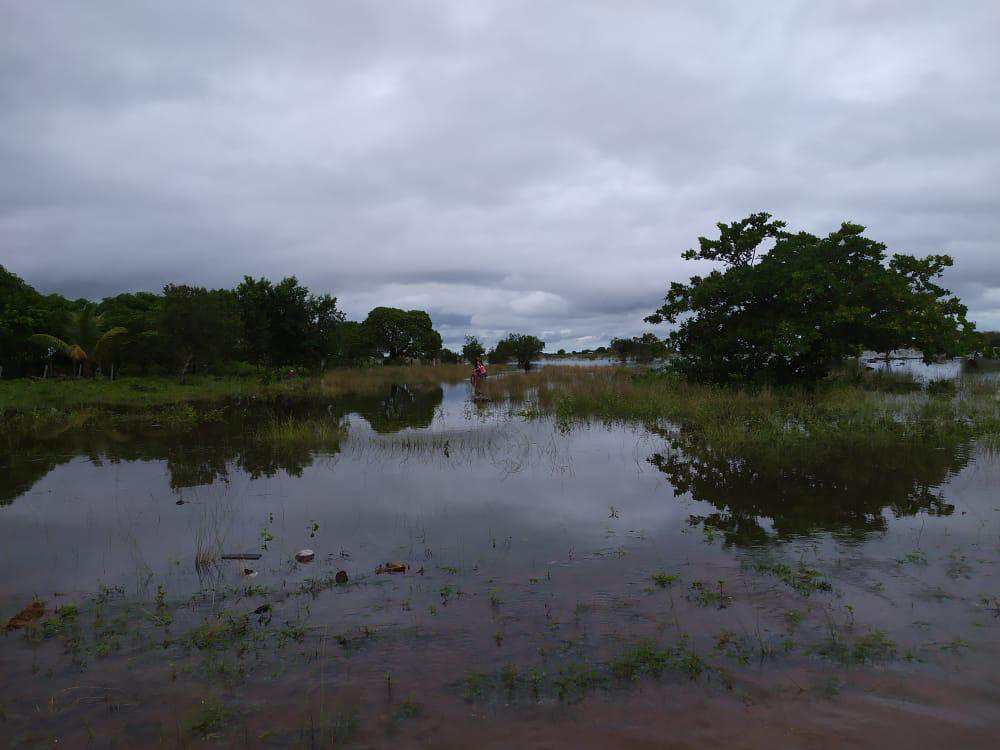Villages in the North and South Rupununi have been cut off from access to Lethem as floodwater from over- flowing creeks and rivers have either covered parts of the roads or washed away sections, making it impassable for small vehicles.
The floods were triggered by heavy rains that have been pounding the villages continuously for the last two days resulting in excessively high water levels.
The village of Massara in the North Rupununi with approximately 200 households is said to be the most affected in the district according to Regional Chairman Bryan Allicock.
Speaking with Stabroek News yesterday, Allicock explained that the water level in the district is continuously rising and the region is pushing to meet the needs of affected families.
He noted that as of yesterday afternoon, 200 food and hygiene hampers were dispatched to the village.
“We may not be able to get directly to the village but we are sending the hampers to sub-districts and then using ATVs and tractors to transport the hampers to them,” he said.
As he spoke of the impacts, he said that no crops from farms can be salvaged as cultivated lands have become waterlogged.
“The farmers at Massara cannot save anything. All the cassava is gone [and] they cannot get to the farming areas because of the height of the water,” he added.
He informed Stabroek News that across the region there has been excessive rainfall since the 24th and while it eased yesterday, the rain clouds were once again hovering over the region.
With regard to the South Rupununi, he said efforts are also being made to distribute additional hampers to affected villages.
“We have to send hampers to Masakenari and Parabara. Both council Toshaos are out in Lethem so we will have them escort the hampers,” he stated before touching on the condition of the roads.
Allicock said the road to Aishalton has been completely cut off to small vehicles while water levels are higher than usual on the alternative road link.
“The safest way to travel is probably by helicopter right now across the region but we cannot afford that because it is US$4,000 an hour, so we are distributing to sub-district councils and then using tractors and ATVs to get to the villages,” he explained.
Allicock emphasised the necessity of the regional body rendering assistance to the villages because if community shopkeepers have to make the trip to Lethem, it will be costly and that will trickle down to villagers making it hard for them to secure food.
To date, he stated, close to 4,000 food and hygiene hampers have been supplied to the region through the assistance of the Civil Defence Commission.
Meanwhile, Immaculata Casimero, resident of Aishalton and representative of the South Rupununi District Council (SRDC), said that many of the farms cultivated with cassava have been inundated for days.
“In Achwib alone, 120 farms cannot be accessed because of the level of water. The water came up very high this year and the farms are flooded so people cannot get to go and reap,” she explained.
She said too that village councils are worried about food security for the next few months as many villagers are unable to reap their crops.
“Those who managed to reap some of the cassava are now making farine but there are many who didn’t reap because of the flooding,” she lamented.
Michael Thomas, Vice-Chairman of the SRDC had told this newspaper that food security over the next three months is under threat.
“At this point there isn’t much that we can do because the cassava roots are not mature. The farmers are trying to harvest but in some areas the water is high already. We never estimated that the flooding will come this high so early in the season,” he observed.
Concerns over food security were also raised with the CDC which visited several affected communities over the weekend and carried out an assessment on the impact of the flooding.
Thomas had noted that while the flooding has been receding, whenever there is intense rainfall the water level rises quickly.
“The earth has a lot of water already so if it stops raining for a three days and then starts again for a while, we get flood. This is the first time in a decade the water levels have been so high and causing so much damage,” he stated.
Casimero further noted that in the village of Karaudarnau, the water in the Rupununi River which runs through the community is the same height as the bridge. The bridge was elevated some years ago to prevent it from becoming impassable during the wet season. This she said, will prevent many from travelling through the village to get business done.
In a statement on Sunday, Director General of the CDC, Lieutenant Colonel Kester Craig, said that he is working with the private sector to source essential items for the affected areas. He also committed to closely monitoring the impacted areas in Region Nine and to work with local authorities to ensure that residents are safe.
Prime Minister Mark Phillips led a delegation of senior government officials to the region on Saturday and flew over several communities to assess the damage himself. He also visited Gunns Strip and Sand Creek, where he distributed relief supplies and interacted with the residents.
In a post on his Facebook page, he stated that while the CDC has shipped over 2,000 hampers to the region, the organisation will also monitor the situation on the ground throughout the coming weeks.





